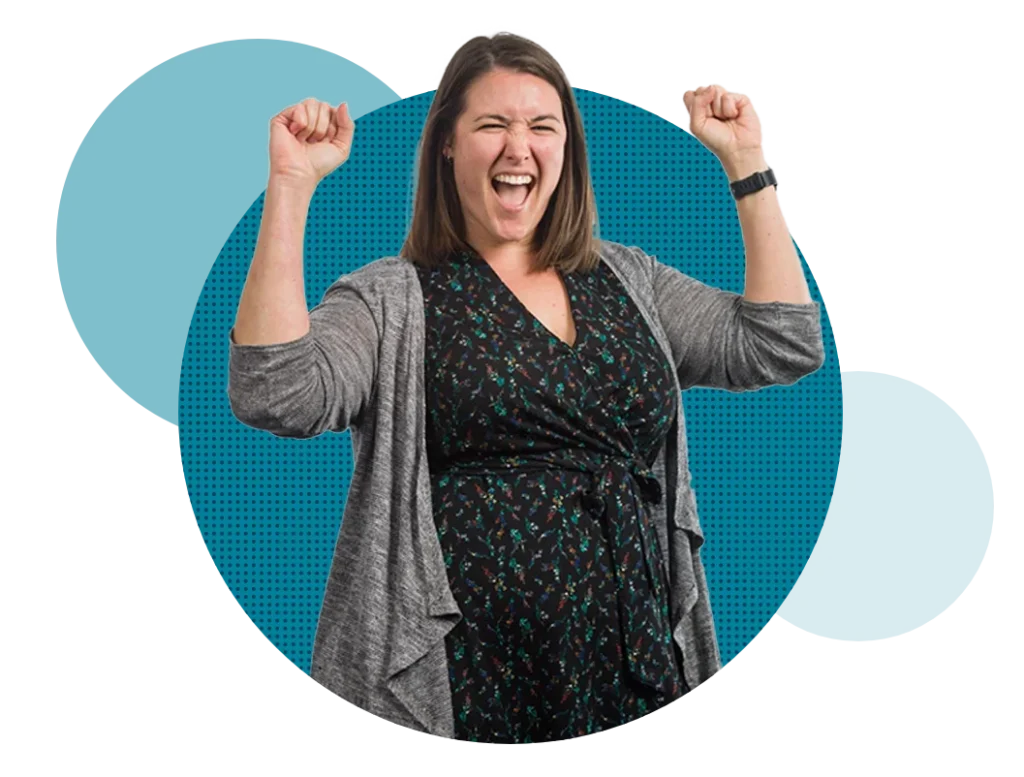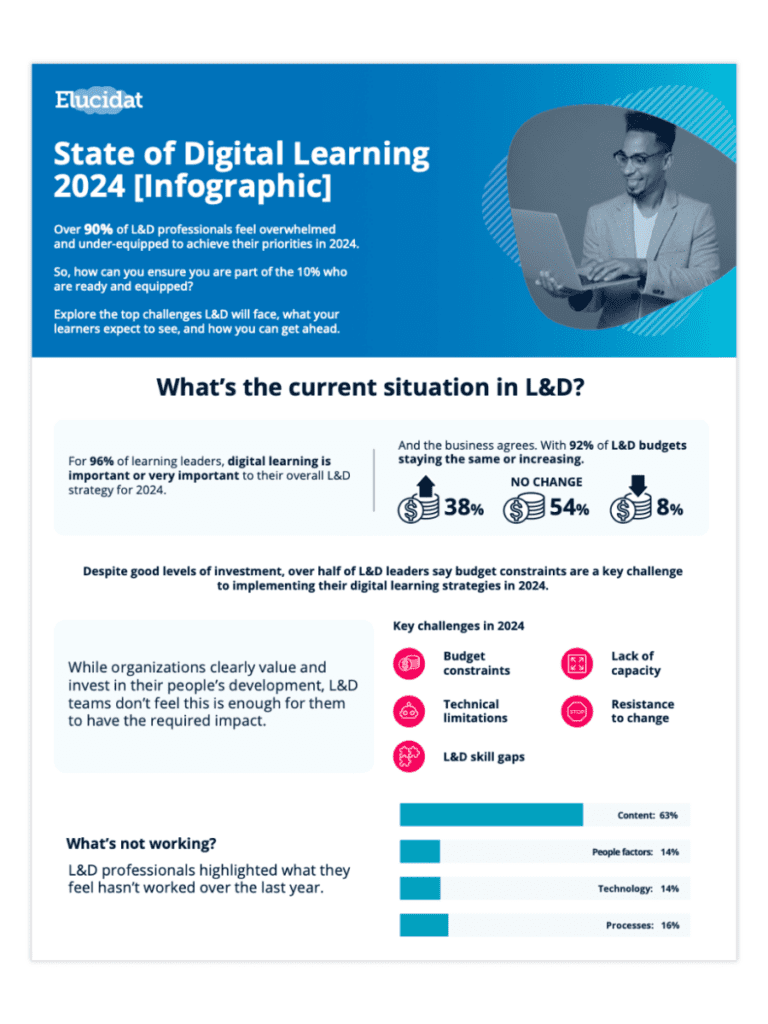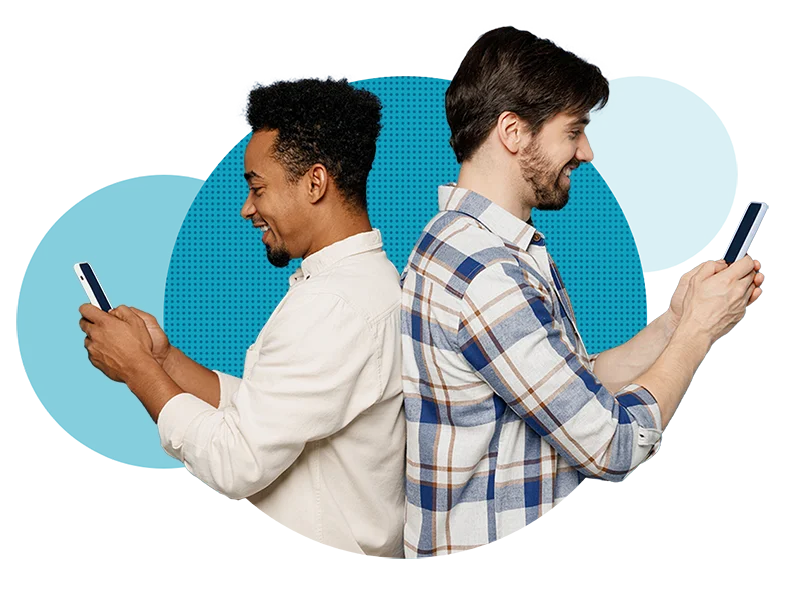Introduction
At Elucidat, we’ve worked with hundreds of elearning teams across dozens of sectors, supporting them as they reach tens of millions of learners between them. They all have their own unique challenges, from achieving digital transformation to efficiently producing elearning content at scale in multiple languages and brands.
Regardless of where they are on their journey, one thing the most successful leaders have in common is recognizing their team is the key to success. They’re all looking for exceptional people who can work together effectively. And they’ve identified the best possible processes to efficiently produce elearning that delivers real-life impact.
This guide will reveal the secrets to their success and help you apply these to your team, including:
- The essential skills you need in your elearning team and where to find them
- Ways to structure elearning teams of different sizes
- What your team members need in order to succeed
- How to empower and supercharge your team for success
Starting out in the world of digital? Preparing to scale up? Looking for more efficient ways to produce people-centred elearning? Whatever your goal, read on to discover how you can build your own winning elearning dream team.
We hope you find this guide useful and, as always, welcome your feedback.

Kirstie Greany
Learning Consultant, Elucidat
Find the right skills

What are the key components of an exceptional piece of elearning?
Most Learning Managers will have their own nuanced answer to this question, but we likely all agree on the foundational principles. At a minimum, great elearning is:
An elearning dream team is one that can deliver on these principles every time, and then add their own flair. To be confident that your team can deliver, there are several core skills to look for.
Bear in mind that you don’t necessarily need a specific person to do each of these four core skills. There are plenty of multi-skilled individuals out there. It’s quite common for Graphic Artists to be experts in a particular authoring tool, or for Learning Designers to be able to manage the commercial side of projects.
Creating effective and engaging learning experiences
Effective elearning experiences are most often created by Digital Learning Designers.
They’ll start by investigating what’s needed to improve the desired performance of a target audience, then design a meaningful, engaging solution to help solve that problem. Learning Designers represent the end user throughout the design process. They hone in on what will help and filter out ideas and content that won’t.

Skills to look for
● Needs analysis – they can uncover the root of performance problems via a consultative approach, and recognize what needs to be fixed
● Creative design – they can design learning experiences that bring content to life, creatively, to engage end users
● Learning design – they recognize how to structure and design experiences and content not only engages end users, but actively helps them to improve their performance in the target areas
● Content filtering – they can curate and smartly filter through content to identify what may be useful and what’s not, to support the design and overall project goal
● User-centered – they can put themselves in the shoes of the learning audience and understand what’s needed, so they can create solutions that engage and work for that audience (also see Design Thinking)
● Stakeholder management – they can proactively work with stakeholders and Subject Matter Experts (SMEs) to elicit what’s needed to make the project a success, and gain buy-in to the design
● Content review and editing – with a keen eye for detail, Learning Designers carry a project over the line and ensure the quality is up to scratch
Bonus skills
- Confident using your elearning authoring platform
- Able to use design software, such as wireframing tools
Ensuring the experience is functional and intuitive
It sounds obvious but it’s too often overlooked; your digital learning must work and be easy to use. An Authoring Tool Expert will help you tick those all-important boxes and produce content smartly and quickly.
They’ll be able to take a design that the Learning Designer has come up with and make it a reality in an authoring platform of choice, quickly and effectively. They can also bring their knowledge of authoring tools to the table and work with Learning and Graphic Designers (and others, as needed) to advise on how the learning design ideas can make the most of the features available.

Skills to look for
● In-depth authoring skills – they know a tool inside and out, and can build content and desired design outcomes efficiently and effectively
● Design-oriented – they can offer solutions and input in the design process via their in-depth knowledge of authoring tools
● Business-minded – they can streamline authoring processes and consider how to set up reusable elements and templates to speed up production
● Quality assurance and user experience skills – they know how to design intuitive navigation and user journeys, and are able to QA a finished product
Bonus skills
- Experience with elearning platforms and upload processes
- Interest in design and learning design
- Development skills in your code-base of choice, if you plan to create bespoke content outside of an authoring tool
Working within reasonable time frames, to budget
Project management skills will help you keep your team and your projects on track.
Keeping an elearning production team running on time and on budget is a job in itself. An elearning Project Manager will guide the rest of the team through an efficient production process. They’ll take responsibility for planning and resourcing, budget, schedule and stakeholder management.

Skills to look for
● Coordination of multi-skilled teams – they enable teams to work together smartly and efficiently to meet project goals
● Stakeholder management – they proactively identify and liaise with stakeholders to ensure they are involved and informed, as required, throughout a project lifecycle
● Progress tracking and reporting – they update stakeholders, when it’s needed
● Risk management – they proactively uncover risks and manage them with the team to keep projects on track
● Scheduling – they can create schedules and take ownership of meeting deadlines
● Budget management – they can assess likely budgets, set targets for teams, and take ownership of sticking to target costs
Bonus skills
- Experience with authoring and elearning platforms
- Some technical knowledge
Don’t forget about your SMEs
Even with these 4 skill sets covered, your team can’t create quality elearning alone. Your SMEs are key to your success. From understanding the context to developing the content, they shape your learning solutions. But their role doesn’t have to end there.
When demand for digital learning is on the rise, many Learning & Development (L&D) teams face a dilemma: steam ahead and risk quality or slow down and not deliver everything. Both strategies have the same result: effective learning isn’t happening at the point that employees need it. But it doesn’t have to be this way.
With an intuitive authoring tool that makes collaboration easy, you can scale up without compromising quality. SMEs are content experts not Learning Designers, Graphic Artists or Project Managers. But with the right tool and your support, you can empower your SMEs to produce high quality elearning. Create templates with best learning practice and consistent branding baked in. Use permissions, review and feedback tools to stay on track. Freeing up you and your team from creating learning content, so you can focus on setting and maintaining standards.

Develop your team’s digital learning skills and strategy
Help your team (and your Subject Matter Experts!) become elearning pros with targeted coaching and consultancy from the Elucidat Learning Consultancy team.
“Partnering with Elucidat experts was the best investment SGS could make. It allowed our team to discover the “Digital Learning Designers” in them. The partnership allowed them to create and deliver with speed and increased their confidence to create the next batch of modules! Thank you Elucidat team.”
Luz Hoyos-Rossier, Global Head of Talent Development at SGS
Where to find people who could be great in L&D
Many organizations look for people who have done similar roles previously to join their team. Candidates like this bring a lot of valuable experience and are likely to hit the ground running. Keep an eye out for these job titles:
Thinking outside the box
There’s also a real benefit to homegrown talent or fresh ideas from different industries. Gamified Learning was heavily influenced by Game Designers moving into the learning industry. And Learning Campaigns wouldn’t be what they are without Marketing and Communications experts turning their hands to digital learning. So, you may also want to consider looking more broadly for your talent, including the following backgrounds:
Structure your elearning team

There are many different ways to structure an elearning team; the one that’s right for you will depend on your situation and your goals.
Consider these factors:
Need to create impactful content at scale?
Opt for an SME-driven dream team
As training needs stack up, we’ve seen some of the world’s leading organizations embracing new ways of working to deliver at speed and scale. Despite working in different industries, these forward-thinking teams use common best practices and processes to open up learning content creation and prioritize their time and resources effectively.
A learning leader sets a vision, then a core team of Learning Designers and Authoring Tool Experts develops a set of reusable templates in an authoring platform that make that vision a reality. They then enable SMEs to work directly in the elearning platform and use the templates provided directly to create content.
Top tip: Explore Elucidat’s range of Learning Accelerator ready-made templates to speed up your organisation’s template creation. The platform will recommend elearning templates based on your project goals. From branching scenarios to game-like quizzes, there’s a design approach ready to help boost your content creation. You just add content (with best practice tips along the way). Simple as that!
“We don’t have a centralized training function, and we want to empower SMEs to build their own content. With the recent introduction of templates in Elucidat, they find it very easy to design their own engaging content.”
Jo Grantham, Training Lead, Oxfam
Read story
Is working at scale less of a priority?
Let’s explore three other tried and tested team structures:
1. Lean dream team
Graphic Artist and Learning Designer dream team, where both are able to produce content in an elearning platform. An intuitive authoring tool that enables high-end results without the need for coding skills is crucial for this set up.
- Learning Designer: Gets how to design for performance
- Graphic Designer/media expert : Great with layouts, can produce/curate imagery, videos etc
2. Multimedia dream team
A Learning Designer heads up a mini production team involving an Authoring Tool Expert, Graphic Artist and Copywriter.
- Copywriting expert: Can add pizzazz to any copy, for a target audience
- Learning Designer: Gets how to design for performance
- Graphic Designer/media expert: Great with layouts, can produce/curate imagery, videos etc.
- Authoring Tool Expert: Internal tool champ
3. Outsource model
A learning leader commissions a third-party supplier to deliver on their vision, retaining accountability for the vision.
- Learning leader: Owns the vision, sets the expectations
- Third party supplier
The Elucidat Learning Consultancy team are here to help!
Find out how they can support your content creation needs with their design and build service.
Changing structures over time
As your team develops and your learners’ needs evolve, your team structure may also need to adapt. More L&D teams than ever are feeling the pressure to keep up with the speed and amount of change in their organisations and are moving to a model that empowers SMEs to contribute to elearning creation. Skills are much more important than roles, so be prepared to flex the roles in your team over time to suit the people working with you and help them deliver the outcomes you need.
Empower and supercharge your team

When you’ve got your people and team structure in place, you can focus on making sure your team’s potential is realized into something amazing.
First, there are some essentials:
The tools and technology your team will need in order to execute their creative ideas
Training in digital learning design for anyone new to the role
These basics are sometimes overlooked, but your team could falter early on without them. Carefully assess the authoring tools available to make sure you’ve got the best one for your needs. Then make sure your team are confident with the best practices and processes that will help them succeed as elearning designers and producers. Provide free training with this self-paced Introduction to Elearning Design program that’s open to all.
Here are 6 techniques we’ve seen work effectively:
1. Set a clear vision for elearning in your organization
For your elearning team to be successful, they need to be crystal clear what they’re aiming for. So, take charge. Or recruit an experienced Learning Designer to do it for you! If you’re producing online learning in-house or with third parties, it’s key that you have a clear vision for what “great elearning” looks like.
“We don’t have a centralized training function, and we want to empower SMEs to build their own content. With the recent introduction of templates in Elucidat, they find it very easy to design their own engaging content.”
Jo Grantham, Training Lead, Oxfam
Read story
Create a manifesto that everyone commits to. The starting points for this? Your end users and your analytics. Dig into data about what’s worked well, what hasn’t and why. Pair this with some user surveys and interviews and focus on what helps boost performance: digital or not. Take what you learn and set out a clear vision for elearning in your business.
Our Learning Consultancy team can guide you through this process in an interactive workshop.
 Get practical:
Get practical:
2. Empower your team to truly represent end users
Teams that create people-centered elearning embody their end users and represent them and their needs throughout the entire process. If you are an in-house learning team, your customers are your learners. This is where your #1 focus needs to be.

Learn more about what the modern learner wants in our State of Digital Learning Report.
“Think about how you can advocate for your learners. Ask why is this useful? What’s the purpose we serve by introducing this, by using this data, by buying this LMS, by implementing this program. I really think that we have an opportunity to influence in a broader way…and from a learner centric perspective.”
Leading with purpose through thoughtful L&D
Stella Lee, founder of Paradox Learning
However, you configure your team, empower them to talk with and involve end users, monitor learning analytics and get up close to user needs. If an SME or business manager is standing in the way, then make the case for why connecting designers to end users and goals make sense.
 Get practical:
Get practical:
3. Make data analysis part and parcel of core roles
It’s all too easy for us to assume that we’ve understood our audience correctly; but the proof is in the engagement data. Currently, less than 10% of Learning Designers make data-based changes after an elearning project has gone live, missing valuable opportunities to increase the impact a course has.
Arm your team with analytics feeds for their projects so they can monitor what’s working and what’s not and make tweaks to increase the project’s engagement and reach. Make it part of their role that they should make changes beyond launch. Ask them to report back on how it’s doing. At a macro level, ensure your learning leaders and managers are looking at data feeds across projects.
“When it comes to measuring the impact of training, [it’s about] being able to get a good signal of the extent to which learning has influenced behavior, actions, habits, performance, and business outcomes…The data, evidence or facts show that this happened, not just because of training, but because training was part of an overall strategy.”
Using L&D detection to find measures that show purposeful impact
Kevin M. Yates, L&D Detective
 Get practical:
Get practical:
4. Get your elearning team thinking commercially – even if the content’s not for sale
Thinking commercially about elearning production, even if it’s not for sale, helps everyone focus on value. We find it drives better design results and smarter working as a result. If you have department leads commissioning elearning projects for your team to do, take a consultative lead. Is it business critical? Who’s it for? What’s its shelf-life? What’s the real problem it’s trying to fix? Are you sure a course is the right fit?
“We’ve been spending about £40 billion a year on L&D since 2000. It’s a big number. Globally, the estimated year-on-year is about half a trillion. But productivity has remained the same. So, either we’re wasting money on the wrong things, we haven’t developed the right skills or capability, or we’ve not really understood where we need to put those investments.”
Tackling flatlining business productivity with future focused L&D
Simon Gibson, Group Head of Learning & Development at Marks and Spencer
Read more on how to demonstrate ROI with Elucidat.
 Get practical:
Get practical:
5. Support smarter working – reuse, recycle, recoup
One powerful way to develop elearning content with a commercial hat on is to think about ways you can reuse existing content. Step back and assess how to avoid your team starting from scratch every time, saving them loads of time.
Can you re-use global styles, layouts, pages, menus, even whole topics? For example, swapping out the videos in a branching scenario means users get a new learning experience, with a consistent interface, in half the time.
Read more on how to demonstrate ROI with Elucidat.
 Get practical:
Get practical:
“Our biggest consumer in terms of elearning is the Sports department. Our team members must be able to find everything they need to sell the products season after season. Skills leaders create the content, and field and product experts review the courses to ensure their quality. Our courses are created in France where the sports team is based. Other countries are then able to duplicate, translate and adapt to their local practices if needed.”
Sophie Vanhems, Skill Leader, Decathlon
Read story
Elucidat features to help your team work smarter, not harder
- Create templated projects or page layouts for your team to use as a base for different projects
- Create a brand style once, then apply it to multiple courses with one click
- Upload approved images to your asset library, so your team can choose from them easily
- Use parent courses to create and maintain versions easily
- Collaborate with stakeholders using the Review feature for speedy testing and refinement
6. Foster a community for efficiency and invigoration
Last, but not least, build a sense of community and sharing within your team to encourage fresh ideas and collaboration.
Teams that work together create greater results, faster. Encourage sharing, peer reviews, joint brainstorming, project re-use, and inspiration sessions via a community of practice. Don’t let your team’s ideas get siloed or stale! For big teams, consider an online community portal or forum.
“When it comes to measuring the impact of training, [it’s about] being able to get a good signal of the extent to which learning has influenced behavior, actions, habits, performance, and business outcomes…The data, evidence or facts show that this happened, not just because of training, but because training was part of an overall strategy.”
Using L&D detection to find measures that show purposeful impact
Kevin M. Yates, L&D Detective
 Get practical:
Get practical:
Want to find out more?
Get some insider tips on how to set up successful ways of working from L&D leaders at Aviva, nCino, Coca-Cola and D&G.
Power up your dream team

With a clear vision, the right tools, and the perfect combination of skill sets, you can create a winning elearning dream team that works efficiently and effectively at scale.
A smarter approach to producing innovative elearning at scale
Get your team on-brand and on-time. Elucidat is the go-to elearning authoring platform for delivering impactful elearning experiences at scale among the world’s leading companies.
As well as the latest in authoring tool features, you’ll benefit from:
- A library of expert-designed elearning templates to help you create training 4 x faster
- Advanced user permissions to support how your dream team works
- Brand control and asset management
- Built-in learning analytics
- Built-in translation process
Already an Elucidat customer?
Speak to our Learning Consultancy team to explore how they can help you create your own dream team.








 Get practical:
Get practical: